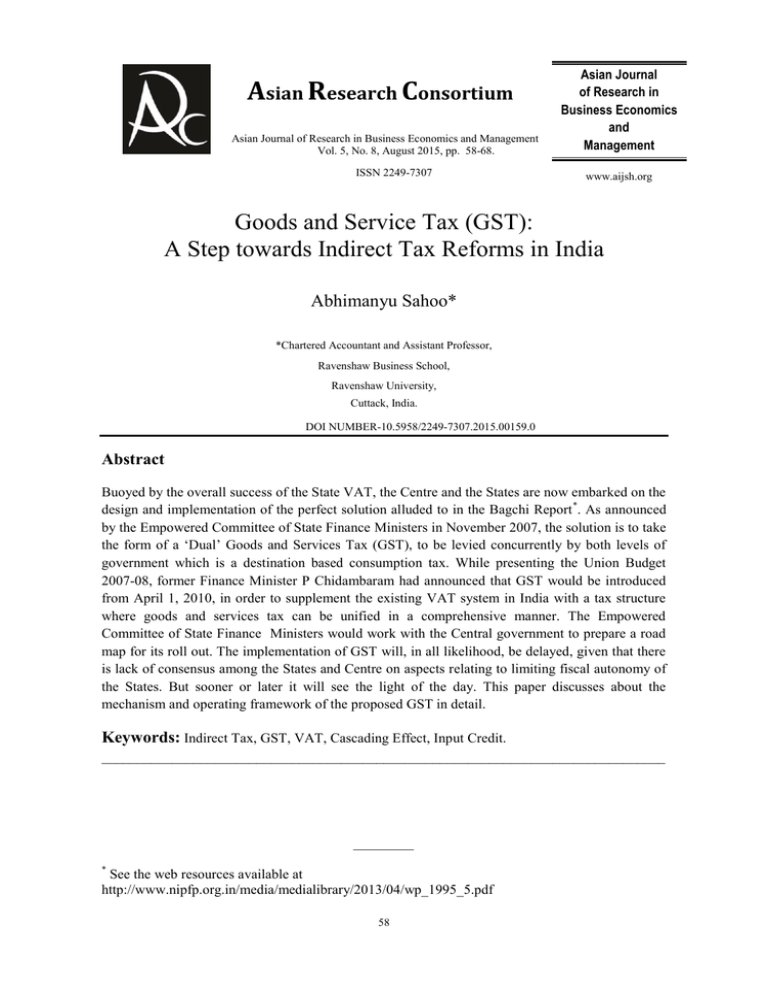Goods and Service Tax (GST): A Step towards Indirect
advertisement

Asian Research Consortium Asian Journal of Research in Business Economics and Management Vol. 5, No. 8, August 2015, pp. 58-68. ISSN 2249-7307 Asian Journal of Research in Business Economics and Management www.aijsh.org Goods and Service Tax (GST): A Step towards Indirect Tax Reforms in India Abhimanyu Sahoo* *Chartered Accountant and Assistant Professor, Ravenshaw Business School, Ravenshaw University, Cuttack, India. DOI NUMBER-10.5958/2249-7307.2015.00159.0 Abstract Buoyed by the overall success of the State VAT, the Centre and the States are now embarked on the design and implementation of the perfect solution alluded to in the Bagchi Report *. As announced by the Empowered Committee of State Finance Ministers in November 2007, the solution is to take the form of a ‘Dual’ Goods and Services Tax (GST), to be levied concurrently by both levels of government which is a destination based consumption tax. While presenting the Union Budget 2007-08, former Finance Minister P Chidambaram had announced that GST would be introduced from April 1, 2010, in order to supplement the existing VAT system in India with a tax structure where goods and services tax can be unified in a comprehensive manner. The Empowered Committee of State Finance Ministers would work with the Central government to prepare a road map for its roll out. The implementation of GST will, in all likelihood, be delayed, given that there is lack of consensus among the States and Centre on aspects relating to limiting fiscal autonomy of the States. But sooner or later it will see the light of the day. This paper discusses about the mechanism and operating framework of the proposed GST in detail. Keywords: Indirect Tax, GST, VAT, Cascading Effect, Input Credit. ________________________________________________________________________________ * See the web resources available at http://www.nipfp.org.in/media/medialibrary/2013/04/wp_1995_5.pdf 58 Sahoo (2015). Asian Journal of Research in Business Economics and Management, Vol. 5, No. 8, pp. 58-68. References http://rajtax.gov.in/vatweb/download/gst/13th%20FCR.pdf http://www.manupatrafast.in/NewsletterArchives%5Clisting%5CGST%20ELP%5C2015%5CFeb/ ELP%20GST%20Insight,%20Bulletin%205.pdf http://gstindia.com/ http://www.cbec.gov.in/deptt_offcr/gst-status-18032014.pdf http://finmin.nic.in/gst/index.asp http://fincomindia.nic.in/writereaddata%5Chtml_en_files%5Coldcommission_html/fincom13/discu ssion/report28.pdf http://www.prsindia.org/uploads/media/Constitution%20115/GST%20SC%20Report.pdf http://www.iticnet.org/images/Overview%20of%20Proposed%20GST%20in%20India%207Mar20 14.pdf http://en.wikipedia.org/wiki/Goods_and_Services_Tax_%28India%29 http://dor.gov.in/Gstintro http://www.nipfp.org.in/media/medialibrary/2013/04/wp_2008_57.pdf http://www.ijccr.com/January2014/5.pdf 59


